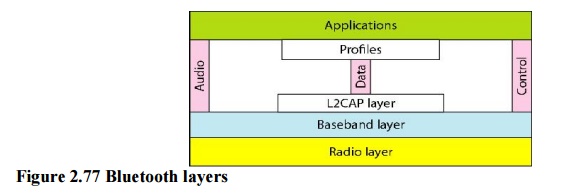Chapter: Computer Networks : Data Link Layer
Bluetooth: Architecture and Devices
Bluetooth
Bluetooth
is a wireless LAN technology designed to connect devices of different functions
such as telephones, notebooks, computers (desktop and laptop), cameras,
printers, coffee makers, and so on. A Bluetooth LAN is an ad hoc network, which
means that the network is formed spontaneously; the devices, sometimes called
gadgets, find each other and make a network called a piconet.
Bluetooth
technology is the implementation of a protocol defined by the IEEE 802.15
standard. The standard defines a wireless personal-area network (PAN) operable
in an area the size of a room or a hall.
1. Architecture
Bluetooth
defines two types of networks: piconet and scatternet.
Piconets
A Bluetooth
network is called a piconet, or a small net. A piconet can have up to eight
stations, one of which is called the primary, the rest are called secondaries.
All the secondary stations synchronize their clocks and hopping sequence with
the primary. Note that a piconet can have only one primary station. The
communication between the primary and the secondary can be one-to-one or
one-to-many.

Scatternet
Piconets
can be combined to form what is called a scatternet. A secondary station in one
piconet can be the primary in another piconet. This station can receive
messages from the primary in the first piconet (as a secondary) and, acting as
a primary, deliver them to secondaries in the second piconet. A station can be
a member of two piconets.

2. Bluetooth Devices
A
Bluetooth device has a built-in short-range radio transmitter. The current data
rate is 1 Mbps with a 2.4-GHz bandwidth. This means that there is a possibility
of interference between the IEEE 802.11b wireless LANs and Bluetooth LANs.
Bluetooth
Layers
Bluetooth
uses several layers that do not exactly match those of the Internet model
Radio Layer
The radio
layer is roughly equivalent to the physical layer of the Internet model.
Bluetooth devices are low-power and have a range of 10 m.

Band
Bluetooth
uses a 2.4-GHz ISM band divided into 79 channels of 1 MHz each.
FHSS
Bluetooth
uses the frequency-hopping spread spectrum (FHSS) method in the physical layer
to avoid interference from other devices or other networks. Bluetooth hops 1600
times per second, which means that each device changes its modulation frequency
1600 times per second. A device uses a frequency for only 625µ s (1/1600 s)
before it hops to another frequency; the dwell time is 625µ s
Modulation
To
transform bits to a signal, Bluetooth uses a sophisticated version of FSK,
called GFSK. GFSK has a carrier frequency. Bit 1 is represented by a frequency
deviation above the carrier; bit 0 is represented by a frequency deviation
below the carrier. The frequencies, in megahertz, are defined according to the
following formula for each channel:
fc=2402+n, n =0,
1,2,3, ..., 78
Baseband Layer
The
baseband layer is roughly equivalent to the MAC sublayer in LANs. The access
method is TDMA. The primary and secondary communicate with each other using
time slots. The length of a time slot is exactly the same as the dwell time,
625 µ s. This means that during the time that one frequency is used, a sender
sends a frame to a secondary, or a secondary sends a frame to the primary. Note
that the communication is only between the primary and a secondary; secondaries
cannot communicate directly with one another.
TDMA
Bluetooth
uses a form of TDMA that is called TDD-TDMA (time division duplex TDMA).
TDD-TDMA is a kind of half-duplex communication in which the secondary and
receiver send and receive data, but not at the same time (half duplex);
however, the communication for each direction uses different hops. This is
similar to walkie-talkies using different carrier frequencies.
L2CAP
The
Logical Link Control and Adaptation Protocol, or L2CAP (L2 here means LL), is
roughly equivalent to the LLC sublayer in LANs. It is used for data exchange on
an ACL link; SCQ channels do not use L2CAP. The I6-bit length field defines the
size of the data, in bytes, coming from the upper layers. Data can be up to
65,535 bytes. The channel ID (CID) defines a unique identifier for the virtual
channel created at this level.
Connecting LANs, Backbone Networks, and Virtual
LANs
LANs do
not normally operate in isolation. They are connected to one another or to the
Internet. To connect LANs, or segments of LANs, we use connecting devices.
Connecting devices can operate in different layers of the Internet model.
Related Topics